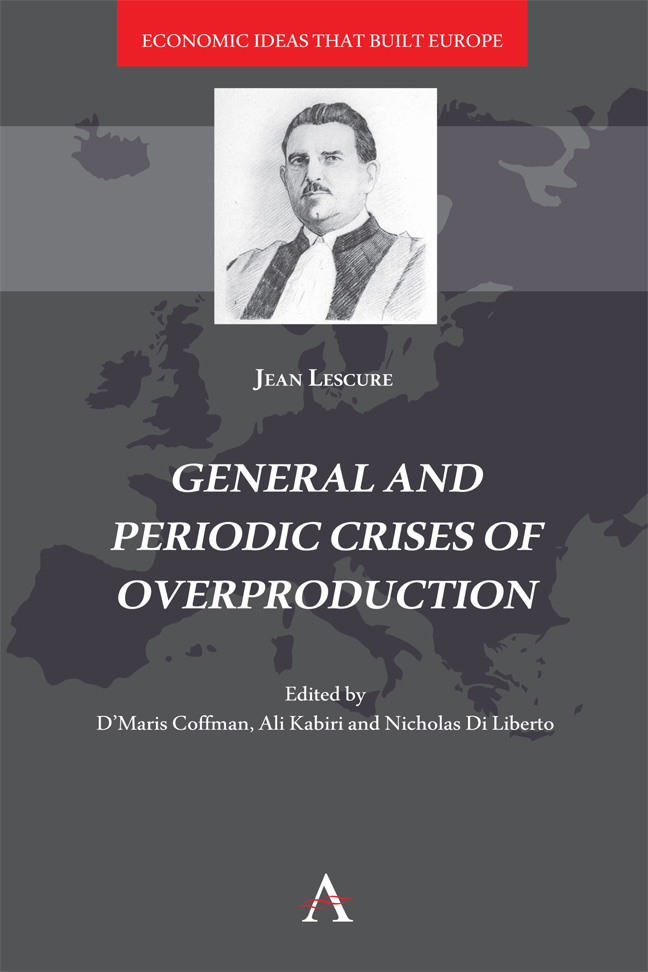Book contents
- Frontmatter
- Contents
- Acknowledgements
- Introduction: Jean Lescure on the Role of Solidarité in Industrial Economies and Among the Social Sciences
- Translator's Note
- General and Periodic Crises of Overproduction
- List of Figures
- List of Tables
- Preface to the Third Edition
- Preface to the Fourth Edition
- Preface to the Fifth Edition
- Volume One The Phenomenon
- Volume Two Causes and Remedies
- Conclusion
- Annexes
- Appendix One Bibliography of the Works Cited by Jean Lescure
- Appendix Two Bibliography of the Works of Jean Lescure
- Index
Chapter One - The Phenomenon
Published online by Cambridge University Press: 01 March 2024
- Frontmatter
- Contents
- Acknowledgements
- Introduction: Jean Lescure on the Role of Solidarité in Industrial Economies and Among the Social Sciences
- Translator's Note
- General and Periodic Crises of Overproduction
- List of Figures
- List of Tables
- Preface to the Third Edition
- Preface to the Fourth Edition
- Preface to the Fifth Edition
- Volume One The Phenomenon
- Volume Two Causes and Remedies
- Conclusion
- Annexes
- Appendix One Bibliography of the Works Cited by Jean Lescure
- Appendix Two Bibliography of the Works of Jean Lescure
- Index
Summary
The good years alternate with the bad, and the often-quoted parable about fat cows and lean cows has lost none of its vivid meaning. However, the evolution of contemporary societies toward capitalism has had an impact upon the phenomenon of alternating years of crisis and prosperity.
Until the eighteenth century, production remained largely agricultural; thus, crises were almost always agricultural. As fickle as the seasons and the harvest, famine is its most sinister form. Nowadays, thanks to the means of transport and communication, famines have disappeared, but industrial and commercial crises have become more frequent.
We shall distinguish between crises of production, consumption, circulation and distribution. However, if we encounter these different crises in isolation, we also encounter them together as general crises of production, consumption, circulation and distribution.
In his Cours de philosophie positive, Auguste Comte writes, ‘Strictly speaking, the progress of civilization does not run along a straight line; rather it moves through a series of unequal and variable oscillations around a mean which always tends to prevail.’ Nothing is truer even from an economic point of view.
During the nineteenth and twentieth centuries, economic growth has ceaselessly followed depression. In very general terms, we could say that the world economy went through a period of growth between 1845 and 1873, followed by a period of decline between 1873 and 1894, followed by a new period of growth between 1895 and 1920 and a new period of decline starting with the crisis of 1920. In more specific terms, we note periods of depression between 1845 and 1873 and between 1895 and 1920; while periods of growth occur from 1873 to 1874 and from 1920 to 1931.
The general overproduction crisis occurs at the point where a growth period lasting three to five years intersects with a depression of a similar duration. It is moreover a periodic crisis.
The study of crises implies the examination of periods of growth and periods of depression and, as these crises are general, the examination of production, consumption, circulation and distribution in periods of growth and of depression. A historical study will help us demonstrate the identity of the phenomenon in time and, subsequently, its scientific validity. A theoretical part will enable us to describe the characteristic features of the economic phenomenon.
- Type
- Chapter
- Information
- General and Periodic Crises of Overproduction , pp. 63 - 350Publisher: Anthem PressPrint publication year: 2023

